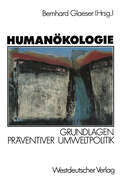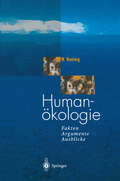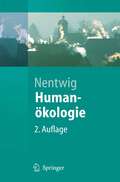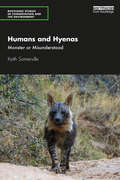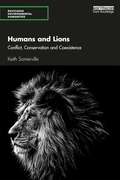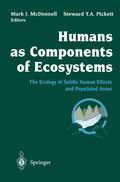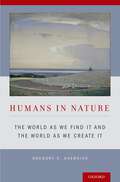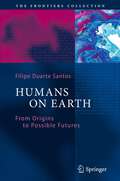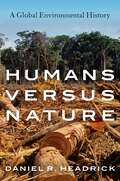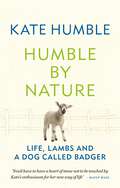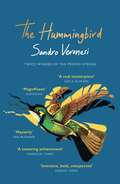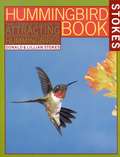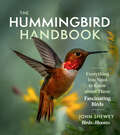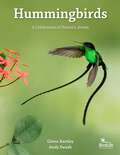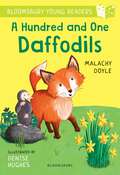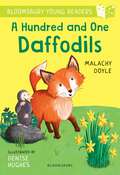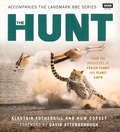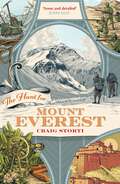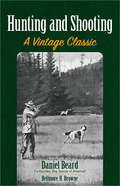- Table View
- List View
Humanökologie: Grundlagen präventiver Umweltpolitik
by Bernhard GlaeserKann Humanökologie zur Fundierung einer präventiven Umweltpolitik beitragen? Nach der Diskussion der Ansprüche präventiver Umweltpolitik zwischen Theorie und Praxis wird der Forschungsansatz "Humanökologie" unter sozialwissenschaftlichem Blickwinkel vorgestellt. Sodann wird die Frage des Begründungszusammenhangs einer umweltbezogenen Ethik behandelt, Anwendung und Umsetzbarkeit humanökologischer Überlegungen werden anhand verschiedener Politikbereiche getestet, Pro und Contra der Realisierungschancen einer präventiven Umweltpolitik erörtert.
Humanökologie: Fakten - Argumente - Ausblicke
by Wolfgang NentwigWolfgang Nentwig stellt die derzeit brennendsten Umweltaspekte in ihrer Gesamtproblematik anschaulich dar. Historische Zusammenhänge, Entwicklungen und Wechselwirkungen machen die Umweltprobleme transparent. Jeder, der kompetent mitreden möchte, erhält hier fundierte Fakten und Argumente.
Humanökologie: Fakten - Argumente - Ausblicke (Springer-Lehrbuch)
by Wolfgang NentwigMit dem Buch liefert der Autor nicht nur eine Bestandsaufnahme des Gebietes, sondern setzt Themen wie das Bevölkerungswachstum und die Veränderung der Umwelt in ihren historischen Zusammenhang. Er beschreibt Trends und systematisiert komplexe Wechselwirkungen. Dabei entwickelt er eigene Ideen und bezieht deutlich Stellung. Die 2. Auflage wurde komplett überarbeitet und aktualisiert. Illustriert mit vielen Beispielen, Hintergrunddaten und vielen Abbildungen bieten die Kapitel - auch einzeln - eine spannende Lektüre.
Humans and Hyenas: Monster or Misunderstood (Routledge Studies in Conservation and the Environment)
by Keith SomervilleHumans and Hyenas examines the origins and development of the relationship between the two to present an accurate and realistic picture of the hyena and its interactions with people. The hyena is one of the most maligned, misrepresented and defamed mammals. It is still, despite decades of research-led knowledge, seen as a skulking, cowardly scavenger rather than a successful hunter with complex family and communal systems. Hyenas are portrayed as sex-shifting deviants, grave robbers and attackers of children in everything from African folk tales through Greek and Roman accounts of animal life, to Disney’s The Lion King depicting hyenas with a lack of respect and disgust, despite the reality of their behaviour and social structures. Combining the personal, in-depth mining of scientific papers about the three main species and historical accounts, Keith Somerville delves into our relationship with hyenas from the earliest records from millennia ago, through the accounts by colonisers, to contemporary coexistence, where hyenas and humans are forced into ever closer proximity due to shrinking habitats and loss of prey. Are hyenas fated to retain their bad image or can their amazing ability to adapt to humans more successfully than lions and other predators lead to a shift in perspective? This book will be of great interest to students and scholars in the environmental sciences, conservation biology, and wildlife and conservation issues.
Humans and Hyenas: Monster or Misunderstood (Routledge Studies in Conservation and the Environment)
by Keith SomervilleHumans and Hyenas examines the origins and development of the relationship between the two to present an accurate and realistic picture of the hyena and its interactions with people. The hyena is one of the most maligned, misrepresented and defamed mammals. It is still, despite decades of research-led knowledge, seen as a skulking, cowardly scavenger rather than a successful hunter with complex family and communal systems. Hyenas are portrayed as sex-shifting deviants, grave robbers and attackers of children in everything from African folk tales through Greek and Roman accounts of animal life, to Disney’s The Lion King depicting hyenas with a lack of respect and disgust, despite the reality of their behaviour and social structures. Combining the personal, in-depth mining of scientific papers about the three main species and historical accounts, Keith Somerville delves into our relationship with hyenas from the earliest records from millennia ago, through the accounts by colonisers, to contemporary coexistence, where hyenas and humans are forced into ever closer proximity due to shrinking habitats and loss of prey. Are hyenas fated to retain their bad image or can their amazing ability to adapt to humans more successfully than lions and other predators lead to a shift in perspective? This book will be of great interest to students and scholars in the environmental sciences, conservation biology, and wildlife and conservation issues.
Humans and Lions: Conflict, Conservation and Coexistence (Routledge Environmental Humanities)
by Keith SomervilleThis book places lion conservation and the relationship between people and lions both in historical context and in the context of the contemporary politics of conservation in Africa. The killing of Cecil the Lion in July 2015 brought such issues to the public’s attention. Were lions threatened in the wild and what was the best form of conservation? How best can lions be saved from extinction in the wild in Africa amid rural poverty, precarious livelihoods for local communities and an expanding human population? This book traces man’s relationship with lions through history, from hominids, to the Romans, through colonial occupation and independence, to the present day. It concludes with an examination of the current crisis of conservation and the conflict between Western animal welfare concepts and sustainable development, thrown into sharp focus by the killing of Cecil the lion. Through this historical account, Keith Somerville provides a coherent, evidence-based assessment of current human-lion relations, providing context to the present situation. This book will be of interest to students and scholars of environmental and African history, wildlife conservation, environmental management and political ecology, as well as the general reader.
Humans and Lions: Conflict, Conservation and Coexistence (Routledge Environmental Humanities)
by Keith SomervilleThis book places lion conservation and the relationship between people and lions both in historical context and in the context of the contemporary politics of conservation in Africa. The killing of Cecil the Lion in July 2015 brought such issues to the public’s attention. Were lions threatened in the wild and what was the best form of conservation? How best can lions be saved from extinction in the wild in Africa amid rural poverty, precarious livelihoods for local communities and an expanding human population? This book traces man’s relationship with lions through history, from hominids, to the Romans, through colonial occupation and independence, to the present day. It concludes with an examination of the current crisis of conservation and the conflict between Western animal welfare concepts and sustainable development, thrown into sharp focus by the killing of Cecil the lion. Through this historical account, Keith Somerville provides a coherent, evidence-based assessment of current human-lion relations, providing context to the present situation. This book will be of interest to students and scholars of environmental and African history, wildlife conservation, environmental management and political ecology, as well as the general reader.
Humans as Components of Ecosystems: The Ecology of Subtle Human Effects and Populated Areas
by G. E. LikensHighlighting the importance to ecological studies of incorporating humans and their effects on ecosystems, leading experts from a variety of disciplines address a number of important issues, including:* the prominent role of humans in the function of ecosystems on Earth* why humans have been ignored in ecological studies* approaches taken by social scientists, historians, geographers, economists, and anthropologists in the study of human activities* the emergence of a new ecological paradigm accommodating human activities* methods for studying subtle human effects, and human- populated ecosystems * future research and training required to include humans effectively as components of ecological systems. Of interest to students and researchers in ecology, and to policy-makers and environmental managers. In addition, it makes social scientists aware of new opportunties for integrating their ideas with those of ecologists.
Humans on Earth: From Origins to Possible Futures (The Frontiers Collection)
by Filipe Duarte SantosThis is a wide-ranging and persuasive book written by an undisputed expert. Beginning with a broad history of the Universe, Earth, Life, and Man, it considers the origins and rise of science and technology, before moving on to discuss the present state of the world and its/our possible futures. Humans on Earth then addresses the main challenges for social and economic development in the 21st century in the context of global change. It presents a detailed but non-technical analysis of questions relating to climate change, our dependence on fossil fuels, deforestation, loss of biodiversity, desertification, and air, water, soil, and ocean pollution, as well as problems related to overpopulation, poverty, social and economic inequalities, and conflict potential. The three main, but largely mutually exclusive, discourses on human development and the environment are described and discussed. The main emphasis is on the risks and uncertainties of the short-term future – the next 50 to 100 years – with regard to environmental degradation and the sustainability of our growth paradigm. "... a sweeping, thoughtful view of the role of humans in shaping our modern world." Paul Epstein, Center for Health and the Global Environment, Harvard Medical School
Humans versus Nature: A Global Environmental History
by Daniel R. HeadrickSince the appearance of Homo sapiens on the planet hundreds of thousands of years ago, human beings have sought to exploit their environments, extracting as many resources as their technological ingenuity has allowed. As technologies have advanced in recent centuries, that impulse has remained largely unchecked, exponentially accelerating the human impact on the environment. Humans versus Nature tells a history of the global environment from the Stone Age to the present, emphasizing the adversarial relationship between the human and natural worlds. Nature is cast as an active protagonist, rather than a mere backdrop or victim of human malfeasance. Daniel R. Headrick shows how environmental changes--epidemics, climate shocks, and volcanic eruptions--have molded human societies and cultures, sometimes overwhelming them. At the same time, he traces the history of anthropogenic changes in the environment--species extinctions, global warming, deforestation, and resource depletion--back to the age of hunters and gatherers and the first farmers and herders. He shows how human interventions such as irrigation systems, over-fishing, and the Industrial Revolution have in turn harmed the very societies that initiated them. Throughout, Headrick examines how human-driven environmental changes are interwoven with larger global systems, dramatically reshaping the complex relationship between people and the natural world. In doing so, he roots the current environmental crisis in the deep past.
Humans versus Nature: A Global Environmental History
by Daniel R. HeadrickSince the appearance of Homo sapiens on the planet hundreds of thousands of years ago, human beings have sought to exploit their environments, extracting as many resources as their technological ingenuity has allowed. As technologies have advanced in recent centuries, that impulse has remained largely unchecked, exponentially accelerating the human impact on the environment. Humans versus Nature tells a history of the global environment from the Stone Age to the present, emphasizing the adversarial relationship between the human and natural worlds. Nature is cast as an active protagonist, rather than a mere backdrop or victim of human malfeasance. Daniel R. Headrick shows how environmental changes--epidemics, climate shocks, and volcanic eruptions--have molded human societies and cultures, sometimes overwhelming them. At the same time, he traces the history of anthropogenic changes in the environment--species extinctions, global warming, deforestation, and resource depletion--back to the age of hunters and gatherers and the first farmers and herders. He shows how human interventions such as irrigation systems, over-fishing, and the Industrial Revolution have in turn harmed the very societies that initiated them. Throughout, Headrick examines how human-driven environmental changes are interwoven with larger global systems, dramatically reshaping the complex relationship between people and the natural world. In doing so, he roots the current environmental crisis in the deep past.
Humble by Nature: Life, lambs and a dog called Badger (Kate Humble)
by Kate Humble'You'd have to have a heart of stone not to be touched by Kate's enthusiasm for her new way of life' - Daily MailIn 2007, after 20 years of living in London, Kate Humble and her husband Ludo decided it was time to leave city life behind them. Three years later, now the owner of a Welsh smallholding, Kate hears that a nearby farm is to be broken up and sold off. Another farm lost; another opportunity for a young farmless farmer gone. Desperate to stop the sale, Kate contacts the council with an alternative plan - to keep the farm working and to run a rural skills and animal husbandry school alongside it. Against all odds, she succeeds.Here, in Humble by Nature, Kate shares with us a highly personal account of her journey from London town house to Welsh farm. Along the way we meet Bertie and Lawrence the donkeys, Myfanwy and Blackberry the pigs and goats Biscuit and Honey, not forgetting a dog called Badger and his unladylike sidekick Bella. And we are introduced to the tenant farmers Tim and Sarah, the locals who helped and some who didn't, and a whole host of newborn lambs.Full of the warmth and passion for the natural world that makes Kate such a sought after presenter, Humble By Nature is the story of two people prepared to follow their hearts and save a small part of Britain's farming heritage, whatever the consequences.
The Hummingbird: ‘Masterly: a cabinet of curiosities and delights, packed with small wonders' (Ian McEwan)
by Sandro Veronesi'The kind of novel summer is made for: instantly immersive, playfully inventive, effortlessly wise... Comforting and hopeful'Observer'Masterly: a cabinet of curiosities and delights, packed with small wonders'Ian McEwan'Pulls off the extraordinary feat of making you believe he is writing for your ears alone'Howard Jacobson'A remarkable accomplishment, a true gift to the world'Michael Cunningham'Ardent, gripping, and inventive to the core'Jhumpa Lahiri'A spellbinding experience: clever, funny and deeply moving'Roddy DoyleMarco Carrera is 'the hummingbird,' a man with the almost supernatural ability to stay still as the world around him continues to change.As he navigates the challenges of life - confronting the death of his sister and the absence of his brother; taking care of his parents as they approach the end of their lives; raising his granddaughter when her mother, Marco's own child, can no longer be there for her; coming to terms with his love for the enigmatic Luisa - Marco Carrera comes to represent the quiet heroism that pervades so much of our everyday existence.A thrilling novel about the need to look to the future with hope and live with intensity to the very end.THE NO. 1 INTERNATIONAL BESTSELLEROver 300,000 copies soldSoon to be a major motion pictureWinner of the Premio StregaWinner of the Prix du Livre EtrangerBook of the Year for the Corriere della Sera
The Hummingbird Book: The Complete Guide to Attracting, Identifying,and Enjoying Hummingbirds
by Donald Stokes Lillian StokesAttract amazing hummingbirds to your backyard! With this comprehensive, beautifully illustrated guide, you'll find it easy to attract these tiny jewel-like birds to your own yard. With this comprehensive, beautifully illustrated guide, you'll find it easy to attract these tiny, jewel-like birds to your own yard. The Stokes Hummingbird Book provides all the information you need to bring hummingbirds up close, identify them, and understand their fascinating and varied behavior. The book includes:Range maps and full-color photographs to help you identify and locate hummingbirdsInformation on how to select the proper feeders, what to use in them, when to put them up, and when to take them downAdvice on what flowers to plant to attract hummingbirds in your part of the countryAmazing facts about hummingbirds, such as how fast they fly and how much they weighGuidelines for photographing hummingbirdsComplete information on hummingbird behavior, including flight displays, breeding habits, and feedingA special section on attracting orioles, with photographs and behavior guides for each of the eight species found in North AmericaA resource list for hummingbird supplies
The Hummingbird Handbook: Everything You Need to Know about These Fascinating Birds
by John SheweyA must-read for gardeners and birders, The Hummingbird Handbook is a complete guide to attracting, understanding, and protecting hummingbirds.
Hummingbird Salamander: A Novel
by Jeff VanderMeerA speculative thriller about the end of all things, set in an unnamed part of the Pacific Northwest. A harrowing descent into a secret world.
Hummingbirds: A Celebration of Nature's Jewels (WILDGuides #87)
by Glenn Bartley Andy SwashA stunningly illustrated guide to the wonderful world of hummingbirdsWith their glorious colors, glittering iridescence, astonishing powers of flight, and many characteristics unique in the world of birds, hummingbirds are extraordinary—true jewels of nature. This beautiful book is a celebration of all aspects of hummingbirds and their world. It features hundreds of the most spectacular photographs of hummingbirds ever taken, exquisite illustrations, and a lively, readable text that presents the latest scientific information and includes up-to-date details about every species.A familiar sight across much of the Americas, hummingbirds have long captured the imagination and played an important part in myths, legends, and other aspects of human culture. Today, hummingbirds are among the most popular of all birds, sought after by serious and casual birders alike. They inspire questions in anyone lucky enough to see them. How can they fly like that? Why are they so colorful? How many are there? Where and how do they live? How do they survive? This book answers these and many other questions, providing an enlightening and enjoyable guide to hummingbirds that can only deepen their wonder.A definitive yet accessible account of all aspects of hummingbird lifeMore than 540 spectacular color photographs, illustrating all 101 hummingbird genera and over two-thirds of the world’s 369 speciesSpecially commissioned illustrations revealing details of anatomy and behaviorMeticulously researched facts and figures on status, population, distribution, and conservation designations of all the world’s hummingbirds
A Hundred and One Daffodils: Lime Book Band (Bloomsbury Young Readers)
by Malachy DoyleA charming story with a woodland setting, ideal for children practising their reading at home or in school.Dusty the fox cub can't wait for her very first spring; Dad has told her there will be a big party. All Dusty has to do is find 101 daffodils to prove it really is spring. That is a lot of flowers! Will Dusty and her friends be able to find them all? This heart-warming tale from Irish author Malachy Doyle is perfect for Key Stage 1 (KS1) children who are learning to read by themselves. It features engaging illustrations from Denise Hughes and explores the themes of seasons and plant life cycles.Bloomsbury Young Readers are the perfect way to get children reading, with book-banded stories by brilliant authors like Julia Donaldson. With gorgeous colour illustrations and inside cover notes to help children get the most out of stories, this series is ideal for home and school. Guided reading notes written by the Centre for Literacy in Primary Education (CLPE) are available at bloomsburyguidedreading.com.'Every child needs a Bloomsbury Young Reader. Fun, stretching, just the right length, full of adventurous vocabulary and punctuation.' (Julie-Ann McCulloch, Teacher)Book Band: Lime. Ideal for ages 6+.
A Hundred and One Daffodils: Lime Book Band (Bloomsbury Young Readers)
by Malachy DoyleA charming story with a woodland setting, ideal for children practising their reading at home or in school.Dusty the fox cub can't wait for her very first spring; Dad has told her there will be a big party. All Dusty has to do is find 101 daffodils to prove it really is spring. That is a lot of flowers! Will Dusty and her friends be able to find them all? This heart-warming tale from Irish author Malachy Doyle is perfect for Key Stage 1 (KS1) children who are learning to read by themselves. It features engaging illustrations from Denise Hughes and explores the themes of seasons and plant life cycles.Bloomsbury Young Readers are the perfect way to get children reading, with book-banded stories by brilliant authors like Julia Donaldson. With gorgeous colour illustrations and inside cover notes to help children get the most out of stories, this series is ideal for home and school. Guided reading notes written by the Centre for Literacy in Primary Education (CLPE) are available at bloomsburyguidedreading.com.'Every child needs a Bloomsbury Young Reader. Fun, stretching, just the right length, full of adventurous vocabulary and punctuation.' (Julie-Ann McCulloch, Teacher)Book Band: Lime. Ideal for ages 6+.
Hungry Hollow: The Story of a Natural Place
by A.K. DewdneyStarting with an elegant description of a small piece of land called Hungry Hollow, A.K. Dewdney introduces us to its denizens. The reader goes on a guided tour through the many dimensions of our natural habitat, back into prehistoric time and inward to a teeming microscopic world full of strange creatures performing bizarre feats."It surprised me how 220 pages explaining biological phenomena can add up to a literary image of the magic of lifePerhaps this book will go some way to redress the general deficiency in judgement that allows humans to endanger other life forms..." -NEW SCIENTIST
The Hunt: The Outcome Is Never Certain
by Alastair Fothergill Huw CordeyWith over 240 breathtaking photographs and footage from the landmark BBC series, The Hunt captures the dramatic encounters of predator and prey in an entirely new light. Featuring the extraordinary strategies of a huge range of predators, from cheetahs and African wild dogs to killer whales and polar bears, these images and stories will revolutionise what you thought you knew about life in the wild.Whether through speed, stamina or complex subterfuge, each creature’s strategy is honed to its environment – and remarkable adaptations mean that the hunted often can, and do, outwit their hunters. It’s a life-or-death duel where each animal’s skills are stretched to the very limit.The final chapter of the book goes behind the scenes to recount the adventures of the production teams as they themselves stalk their quarry – and are sometimes stalked – to discover never-before-seen species and previously undocumented behaviours. From the producers of Frozen Planet and Planet Earth, The Hunt reveals in astonishing detail the most surprising and significant events in the natural world.
The Hunt for Mount Everest
by Craig StortiThe height of Mt. Everest was first measured in 1850, but the closest any westerner got to Everest during the next 71 years, until 1921, was 40 miles. The Hunt for Mt. Everest tells the story of the 71-year quest to find the world's highest mountain. It's a tale of high drama, of larger-than-life characters-George Everest, Francis Younghusband, George Mallory, Lord Curzon, Edward Whymper-and a few quiet heroes: Alexander Kellas, the 13th Dalai Lama, Charles Bell. A story that traverses the Alps, the Himalayas, Nepal and Tibet, the British Empire (especially British India and the Raj), the Anglo-Russian rivalry known as The Great Game, the disastrous First Afghan War, and the phenomenal Survey of India - it is far bigger than simply the tallest mountain in the world. Encountering spies, war, political intrigues, and hundreds of mules, camels, bullocks, yaks, and two zebrules, Craig Storti uncovers the fascinating and still largely overlooked saga of all that led up to that moment in late June of 1921 when two English climbers, George Mallory and Guy Bullock, became the first westerners-and almost certainly the first human beings-to set foot on Mt. Everest and thereby claimed the last remaining major prize in the history of exploration.With 2021 bringing the 100th anniversary of that year, most Everest chronicles have dealt with the climbing history of the mountain, with all that happened after 1921. The Hunt for Mt. Everest is the seldom-told story of all that happened before.
The Hunt for the Golden Mole: All Creatures Great and Small, and Why They Matter
by Richard GirlingThis story is a quest for an animal so rare that a sighting has never been recorded. The Somali golden mole was first described in 1964, but the sole evidence for its existence is a tiny fragment of jawbone found in an owl pellet. Intrigued by this elusive creature, and what it can tell us about extinction and survival, Richard Girling embarks on a hunt to find the animal and its discoverer - an Italian professor who he thinks might still be alive... Richard's journey comes at a time when one species - our own - is having to reconsider its relationship with every other. He delves into the history of exploration and cataloguing and the tall tales of the great hunters, traces the development of the conservation movement and addresses central issues of extinction and biodiversity.
Hunting and Shooting: A Vintage Classic
by Daniel Beard Bellmore H. BrowneBoy Scouts co-founder and avid outdoorsman "Uncle Dan" Beard offers young readers a clear, enthusiastic introduction to the joys of hunting in this timeless guide. Together with Bellmore H. Browne, an expert mountaineer and big-game hunter, Beard provides practical advice on setting up decoys and blinds as well as useful pointers for everything from shooting waterfowl to upland hunting for quail and grouse. Originally published a century ago, this engagingly written and charmingly illustrated guide imparts timeless wisdom that includes respect for weapons and nature, commonsense safety tips, and helpful hints for enjoying the outdoors. In addition to discussions of trap and field shooting, the authors include a brief survey of the history of firearms and guidance on preparing for a hunting trip. Parents wishing to share the sport of hunting with their growing children will find this classic an ideal place to begin.
